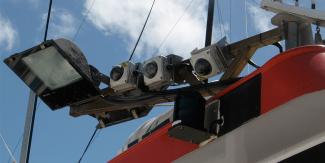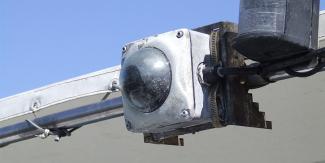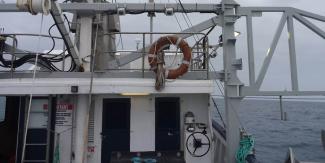AFMA understands that the public cares about the state of fisheries, especially the impact of fishing on the marine environment. That is why we continually strive to find innovative ways, like e-monitoring, to see what is going on in the fisheries that we manage. By doing this, we can make the best decisions to ensure that our fisheries are sustainable now and into the future.



What is electronic monitoring
Electronic monitoring (e-monitoring) is a system of video cameras and sensors capable of monitoring and recording fishing activities, which can be reviewed later to verify what fishers report in their fishing logbooks.
These systems are now compulsory for most commercial fishing boats in the Eastern Tuna and Billfish Fishery, the Western Tuna and Billfish Fishery, the Gillnet, Hook and Trap fishery, and the Midwater Trawl Sector of the Small Pelagic Fishery.
Electronic monitoring also:
- helps AFMA to verify that fishers accurately report the amount and type of fish they catch
- allows AFMA to verify that fishers report all interactions they may have with threatened, endangered and protected species, and
- saves the fishing industry money, as on-board observers are not required for boats that have e-monitoring systems.
Benefits of electronic monitoring
- Fishers can show they are responsible operators and follow fisheries management arrangements.
- Fishers are responsible for their own actions and AFMA can work with individual fishers to improve their practices without penalising responsible fishers.
- Over time the impact of e-monitoring leads to improved data, enabling AFMA to make better management decisions and improve compliance with measures designed to protect both commercial and protected species.
Successful fishery management relies on the collection of data that accurately reflects fishing activities. Data on catch, effort and bycatch is used in scientific stock assessments to make sure that fishing is sustainable now and into the future.
With e-monitoring, AFMA, scientists, and the public can be confident that fishing activities are independently monitored, and that fisheries data is accurately reported. This in turn helps improve the overall quality of scientific assessments and decision-making.
The use of e-monitoring in Australia provides greater insight into fishing operations, including the state of fish stocks and the impacts of fishing on the marine environment. This enhances AFMA’s ability to manage Commonwealth fisheries and provides consumers with confidence that the seafood they buy from Commonwealth managed fisheries is from a sustainable source with a low environmental impact.
How it works
Typically, an e-monitoring system includes several key components:
- three or more video cameras
- a hydraulic gear sensor
- a drum sensor
- a GPS receiver
- satellite communications, and
- a control centre.
Sensors on the drum and the vessel’s hydraulics trigger the video cameras to record both the gear being set and hauled. This fishing information is stored on the system’s hard drive for detailed analysis. Some information such as vessel location is transmitted to AFMA for real-time monitoring.
Monitoring and data collection
AFMA has contracted Archipelago Asia Pacific (AAP), a subsidiary of Archipelago Marine Research, to deliver e-monitoring system installation and associated services, and the analysis of e-monitoring data.
E-monitoring data is used to independently verify fishers’ logbook information. Feedback is also provided to fishers about how accurate their logbook reports are and where improvements can be made. Overseas experience has shown that logbook accuracy is greatly increased with e-monitoring.
AFMA collects fishing data in a number of different ways—e-monitoring is just one of them. Read more about AFMA’s monitoring and data collection programs.
Information for fishers and FAQs
E-monitoring is operating in the Eastern and Western Tuna and Billfish (ETBF and WTBF) fisheries, the Gillnet, Hook and Trap sector of the Southern and Eastern Scalefish and Shark Fishery (SESSF), and the Midwater Trawl sector of the Small Pelagic Fishery.
Do I need to have an e-monitoring system on my boat?
If you operate in the ETBF and WTBF then you are required to have e-monitoring systems installed.
If you use gillnets for more than 50 days per season or longline for more than 100 days per season in the GHAT, you are required to have e-monitoring systems installed.
How do I get an e-monitoring system installed on my boat?
Archipelago Asia Pacific provides e-monitoring equipment and services in Commonwealth fisheries, including the installation and ongoing maintenance of e-monitoring equipment. They also provide training, consultation and data-review services.
You are responsible for organising installation of an e-monitoring system. This can be done by contacting Archipelago Asia Pacific on (02) 6162 1192.
Currently there is a maximum waiting time of up to three months on installations of e-monitoring systems, and if you need to get an e-monitoring system installed you should contact Archipelago Asia Pacific as soon as possible.
Your e-monitoring responsibilities
The system must be operational at all times and must cover all fishing events.
Returning data drives:
Data drives need to be posted to AFMA’s Canberra office on the first landing of every month. Pre-paid, addressed bags will be provided to boats for this purpose. If you need more pre-paid post bags, please contact Archipelago Asia Pacific on (02) 6162 1192.
If there is no footage on the data drive it does not need to be sent to AFMA, but if there is any footage on the drive it needs to be returned to AFMA by the end of the month.
You also need to ensure that you replace the drive before the end of the month when it is 80 per cent full.
Blank drives will be returned to boats. Return addresses for data drives must be included on the Vessel Registration form provided to boats. As with other documents, these will be distributed to boats and are available through the contractor, Archipelago Asia Pacific.
Please also refer to the ‘Your e-monitoring responsibilities’ flyer (PDF, 166 KB) detailing your e-monitoring responsibilities.
Maintaining the system:
You must maintain their system in good working order. This means:
- performing regular function testing:
- after any data drives are exchanged
- before starting a new trip
- after any lengthy periods of inactivity
- if there are any suspected issues with the system.
- reporting technical issues or damage to Archipelago Asia Pacific as soon as practical
- cleaning camera lenses regularly to make sure a there is a clear field of view is at all times, and
- ensuring views of catch handling and gear deployment are unobstructed and well-lit.
You must not tamper with any e-monitoring equipment or data.
Vessel requirements
E-monitoring systems must be powered from the boat’s power supply and have a feed from your vessels hydraulics. Details of the configuration can be obtained by contacting Archipelago Asia Pacific on (02) 6162 1192.
The e-monitoring control centre (in the wheelhouse) is no bigger than a shoebox with peripheral equipment such as cameras and sensors being placed out of the way of on-boat activities.
If the boat’s power supply is not continuous, the system has the ability to go into a low-power state and reactivate when the power is restored.
Benefits of an e-monitoring system
E-monitoring ensures that AFMA and scientists have an accurate record of all catch and effort in a fishery. This is achieved through independent verification of logbook data and means that assessments of fish populations and interactions with protected species will be more accurate and reliable.
E-monitoring is a cost-effective alternative to having an observer on board—and takes up less space than an observer!
Fishers can show that they are following fisheries management arrangements.
Individual operators will be held responsible for their actions rather than the whole fleet.
E-monitoring is only targeted to fishing activity. This means that the system is placed on stand-by when not required, which is less costly and more efficient for the operator.
It is not affected by changes to fishing plans and is always on board and ready to go.
What happens to the data and footage?
The data is given to AFMA in the same way that logbook and other data is provided. The footage will be reviewed by Archipelago Asia Pacific and compared to what has been reported in your logbook. Archipelago Asia Pacific will also provide you with a report on the quality of your video footage identifying any ways you can improve your image quality.
E-monitoring video footage will be securely stored by AFMA and held for a minimum of six months. After this time, the footage may be erased, and the data drive reformatted ready for use again. However, if the review of the footage identifies anything of concern, the footage will be kept for a longer time.
Are the cameras recording 24/7?
The e-monitoring cameras only record fishing activity. Cameras will begin recording when sensors detect signals from the hydraulic drum and/or rotation sensors. Cameras will continue recording for a short while after the drums stop, ensuring that the whole fishing event is recorded. Cameras do not record at any other times.
What if the system breaks down while the boat is fishing?
You must contact Archipelago Asia Pacific to resolve the issue. Contact them on (02) 6162 1192.
If the issue can’t be fixed while at sea you can continue fishing, only if:
- You are not fishing in the Southern Bluefin Tuna Zone, Australian Sea Lion Management Zones, the Coorong Dolphin Zones, or 100 per cent monitoring zones specified in the Upper Slope Dogfish Strategy.
- AAP and AFMA have been notified.
- A time has been scheduled with AAP to repair the unit before commencing a subsequent fishing trip.
If you are intending to fish in a 100 per cent monitoring coverage zone and your system is not fully operational, you must contact AFMA to make arrangements for an observer.
Archipelago Asia Pacific has a spare pool of e-monitoring equipment, so servicing and repairs will be conducted as soon as possible, in most cases when you return to port.
E-monitoring allows AFMA to cross-check logbook data from fishers, to make sure that fishers are reporting everything they are meant to in their logbooks. This means that people choosing Australian seafood can be confident that it has been sustainably fished with a low environmental impact.
75 boats have been installed with e-monitoring systems across the GHAT, ETBF and WTBF fisheries.
At this stage AFMA has implemented e-monitoring in the ETBF, WTBF and GHAT fisheries. Other fisheries still have human observers.
Video footage and other data are recorded on data drives. These are then analysed by Archipelago Asia Pacific and sent to AFMA. Archipelago Asia Pacific also provides AFMA and fishers with a report on the quality of the video footage and a comparison of the fisher’s logbook report with what was seen on camera.
E-monitoring video footage is securely stored by AFMA and held for a minimum of six months. After this time, the footage may be erased, and the data drive reformatted ready for use again. However, if the review of the footage identifies anything of concern, the footage will be kept for a longer time.
The e-monitoring cameras only record fishing activity. Cameras begin recording when sensors detect signals from the fishing gear. Cameras continue recording for a short while after the gear stops, ensuring that the whole fishing event is recorded. Cameras do not record at any other times.